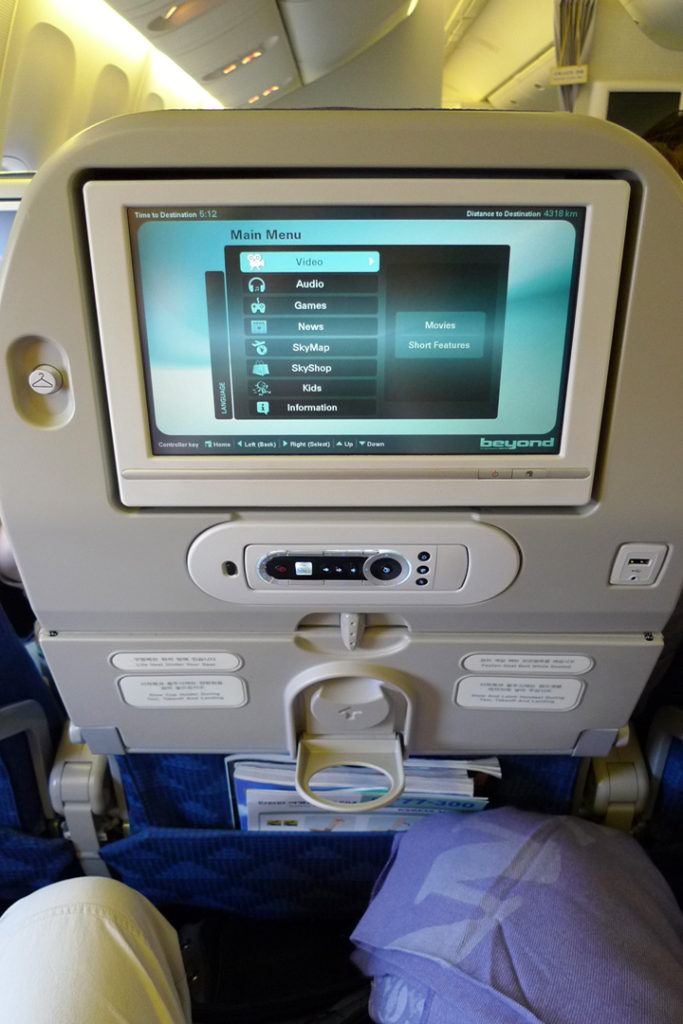Save Our Screens!

Emirates first class suite. Author’s photo.
January 9, 2018
FOR TWO DECADES NOW, seat-back video has been the standard for inflight entertainment. Passengers the world over have grown accustomed to watching movies and shows on the screen in front of them. As well they should; it’s a fantastic amenity. I’ll go so far as to say that it’s the single greatest advent in onboard service in the past fifty years. Onboard comfort is all about the art of distraction, and nothing is a better distraction than being able to binge-watch your favorite TV series or catch a few films.
We’ve come a long way. Flyers of a certain age will remember “the inflight movie,” projected onto a scratched-up bulkhead screen. For the sound, you’d plug a bulky, stethoscope-style headset into the armrest. The picture was always blurry and the audio sounded like it was being transmitted from a submarine. Which usually was fine, because they rarely showed anything you wanted to watch in the first place. Today, passengers can choose between dozens or even hundreds of on-demand options. You can start, stop, pause, rewind…. In first or business class, with oversized screens and noise-reduction headsets, you essentially have your own personal theater. Indeed, one of my favorite guilty pleasures in life is sitting in an airline seat with a meal and a glass of wine, watching something fun on my screen.
Yet the days of the seat-back screen might be numbered. One of the big airline stories making the rounds of late describes how carriers are planning to do away with them. The future of inflight entertainment, we are told, is turning instead to wi-fi streaming, whereby passengers can stream shows and movies directly onto their own laptops, tablets or mobile phones.
And, we keep hearing, this isn’t just something the airlines want. Supposedly it’s what their customers want as well. People find the seat-back screens old-fashioned, or uncool — or something. They want streaming video instead.

Korean Air seat-back video. Author’s photo.
I’m not buying it. Carriers might wish this were the case, but count me among those who don’t believe it. I suspect the media is simply repeating unchecked what airlines are telling them.
I don’t believe it because it doesn’t make sense: With a seat-back screen, you plug in your earphones and go. There are no power issues, no extra cords or wires, and the space in front of you is kept clear for eating, drinking, or whatever. Watching with your own device is cumbersome. For starters there are the sign-on and streaming settings to configure. Then, once you’re watching, you’ve got battery drain to deal with, and/or you’ll need to hook a power cord into an AC outlet, provided your seat has one. Tablet and smartphone screens are often smaller than the seat-back kind, and, if you’re in economy class, you’ll be using up pretty much all of the available tray-table space, making it impossible to enjoy a meal while you’re watching.
Not to mention the recline hazard: Any time you’ve got your laptop propped on your tray, you run the risk of it being crushed when the person in front of you comes hauling back without warning, jamming the screen between the tray and the seat-back (see photo below).
And some carriers won’t be offering a streaming service at all, leaving it up to the passenger to pre-download whatever he or she wants to watch. Fail to do this and, well, I hope there’s something good in the inflight magazine. Imagine a nine, ten, or twelve-hour long-haul and having absolutely nothing to watch. And what about those passengers who don’t carry a laptop or tablet?
Sure, in-seat systems are heavy and expensive — upwards of $10,000 per seat. But all airplane components are expensive, and the typical screen, over the course of its lifespan, will have entertained thousands of passengers. They’re reliable, convenient, and just so downright useful.

Hazardous viewing on China Airlines. Author’s photo.
Now, I have to confess, I sometimes switch off my screen and watch something pre-downloaded on my Macbook instead. I don’t like doing this, for the reasons I just listed, but once in a while there just isn’t anything in the carrier’s library that I want to see. Thus the big caveat in my argument is that an airline needs a decent IFE system to begin with — one that’s easy to navigate, has a wide-enough variety to pick from, and has the hardware (i.e. a big enough screen) to go with it. To that last point, the tiny four or five-inch screens that some airlines have stuck with simply don’t do the trick.
There’s a lot of variation here. My sampling is by no means comprehensive, but I’ve flown a good number of carriers and I have my favorites:
For sheer volume, from blockbusters to Bollywood to documentaries to pop music, nothing comes close to Emirates’ “ICE” system (the letters stand for information, communications, and entertainment). Rest assured you’ll find something to watch or listen to, and the screens in all cabins are huge. The trouble with the Emirates system, however, is that it’s maybe too big for its own good. The ICE guide — a booklet in your seat pocket — is thicker than a novel and confusingly organized; sifting through it all — there are thousands of channels, including many Chinese, Arabic, Hindi and Urdu movies that seem a bit superfluous — can be taxing.
Other airlines have lots to pick from but a clunky user interface. Qatar Airways’ IFE, for example, for an airline of such renown, is appallingly tedious to navigate. Still others have decent usability but limited choices.
My vote for the best all-around system? Delta Air Lines. Theirs is a Panasonic-based platform that is both user-friendly and packed with movies and shows. The layout and navigation functions are the cleanest and most intuitive I’ve seen, and there’s a more than ample, eclectic selection of films and shows. (The one catch is that when clicking into either the TV or movie sections, the default screen shows only the newest additions. Look for the drop-down menu that allows you to access the entire “A-to-Z” archive.) Over the past few years I’ve flown with Emirates, Qatar, Singapore, Cathay Pacific, Korean Air, Thai, and a dozen or so others. Delta’s system beats all of them.
I should note that Delta also has an onboard streaming option called “Delta Studio,” offering much of the same content, at no cost. If that’s your thing, have at it. I’ll keep watching it seat-back style.
Whichever airline we’re talking about, the idea of fumbling around with a computer or an iPad, with wires all over the place and all my personal space taken up, is not a welcome change.
And why should the onus be on the passenger to worry about battery charging, lugging around wireless headphones, and so on, when for two decades the airlines have been supplying the hardware? And what of the millions of people who don’t have tablets or laptops, and/or who resent having to carry them onto a plane in order to enjoy something that heretofore was already there and hard-wired in? I’m still not getting this. Why would a passenger choose to voluntarily make the inflight entertainment experience more cumbersome and more of a pain in the ass?

Moving map on Delta’s outstanding IFE. Author’s photo.
UPDATE: November 1, 2018
Last month, on a Philippine Airlines Airbus A330, I had my first ride in a long-haul cabin with no seat-back entertainment screens. In business class the cabin crew passed out iPads through which you could stream a selection of films and shows. For those in economy it was strictly BYOM (bring your own movies).
The experience was just as I feared it would be: cumbersome and uncomfortable, with a tangle of wires and insufficient space. I’m trying to watch season four of “Better Call Saul” on my MacBook Air. I’ve got a power cord over here, ear pod wires over there, and my screen is in constant danger of being crushed every time the dude in front of me reclines his chair. Worst of all, it’s impossible to enjoy a meal and a show at the same time. There’s simply no room for both a meal tray and a laptop (or even a drink and a laptop). You can eat, or you can watch. But not both.
It wasn’t much different in the business cabin. There were charging issues with the iPads, and even with bigger tables there wasn’t enough room for both tablet and food.
Here’s hoping this is not the future of onboard entertainment.




Leave a Comment
Maximum 1500 characters. Watch your spelling and grammar. Poorly written posts will be deleted!
5 Responses to “Save Our Screens!”
You are viewing newest comments first. Click to reverse order
Agreed! Removing the screens is simply another way to cut costs.
On a nostalgic/”of a certain age” note: before Septemer 2001, I always enjoyed listening in to the pilot/ATC chatter (typically via channel 9 on United), and was enough of a nerd to cause my family roll their eyes when I would describe that were on the “Golden Gate” approach and/or to directed to runway 28L which usually led to a faster taxi to the gate. Anyway, that audio was clear enough with the plastic stethoscopes.
I gave up on using the IFE systems for one reason: The sound is terrible on those provided headphones. Not only are the headphones bad, they also lack noise cancelling (I only fly economy). I wish the built-in IFE systems supported bluetooth audio. I think I saw it once on a plane, but don’t remember what it was. Maybe bluetooth support is something that we’ll see more of in the future? That would be nice.
In economy, this is true. One thing you can do is wear a pair of noise-cancelling headphones from home ON TOP OF the airline-provided earbuds. i do this and and it works quite well.
Count me among the passengers who prefer streaming entertainment on my own devices. For one thing, I know that my devices work — who knows if the seatback screen will be operational or if it’ll be all scratched up and smudged or if the resolution and contrast will be terrible. Add to that, I can use my own headphones via bluetooth without getting all tangled up (I did fly on an airline once that allowed me to connect to the IFE via bluetooth, and that was pretty cool, but it was rare, and I don’t really like connecting my devices to random public infrastructure). Bonus points for airlines who are adding brackets to the seatbacks to hold phones and tablets at a comfortable eye level.
All that said, I do like the seatback screens for displaying the flight progress. When I’m on a flight that still has a seatback screen, I’ll usually set it to the moving map while I watch something else on my laptop.
I agree it’s unlikely ppl will prefer their phone to a bigger screen. But why can’t I cast (airplay) my video from my phone to the seatback display? And really, those video systems remain clunky.
I also don’t see what’s the big deal about no screen. I used to take QF1 which took 36 hours Sydney London ( stops: SIN, BOM, BAH, FRA) with a one-hour stethoscope music programme on loop — we just read books. Pre-9/11 I used to fly HAJ-SFO and SFO-TYO with no luggage or even hand luggage, just a book. Nobody batted an eye.